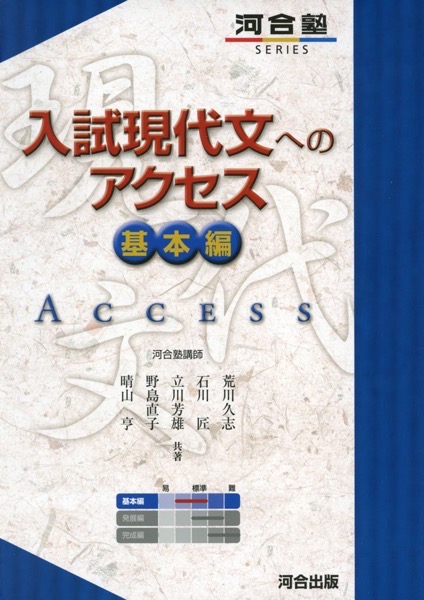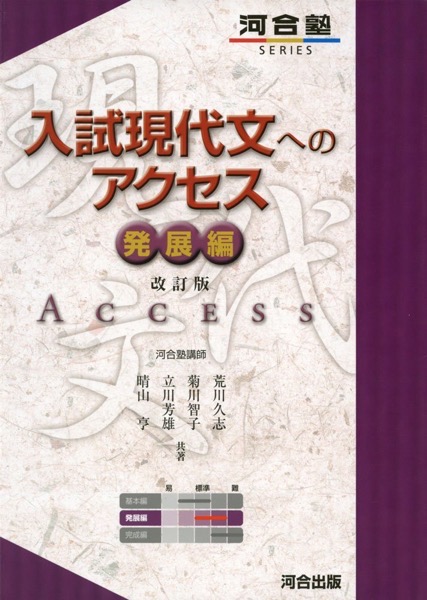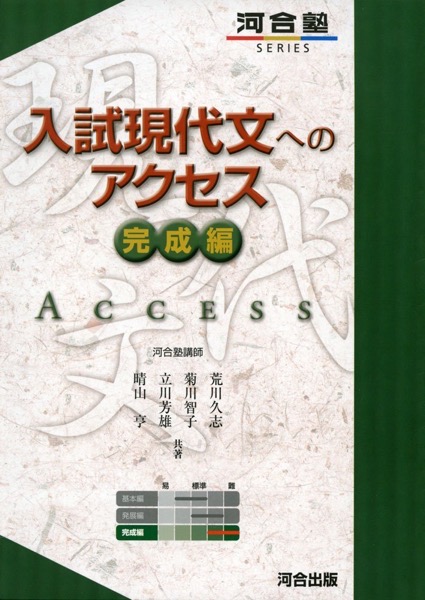

ヒロアカの冬期講習を受付開始 当塾では冬期講習の申し込みを先日より開始しています。 冬期講習のポイント 講習期間は【入塾金無料】 成果の出る勉強法を徹底伝授 【受験生】早慶各学部ポイントを絞って徹底指導 ヒロアカでは、早慶専門塾として各学部ごとの対策を行なっています。 冬期講習では最後の確認として、

当塾では冬期講習の申し込みを先日より開始しています。

ヒロアカでは、早慶専門塾として各学部ごとの対策を行なっています。
冬期講習では最後の確認として、各学部どのようにしたら、良いのか、今年度の予想も踏まえてお伝えしていきます。

1対1の個別での対策も行なっています。
受験学年以外の中学3年〜高校2年生は1対1の個別で個人の学力に合わせた個別のカリキュラムを作成して対策をしていきます。
詳しくはお気軽にお問い合わせください。
現代文の学習において、適切な参考書の選択は欠かせません。しかし、自分のレベルに合った参考書を見つけるのは簡単ではありません。 今回は、現代文の参考書の決定版として知られる「入試現代文へのアクセス」について解説します。 ページ目次「入試現代文へのアクセス」の概要「入試現代文へのアクセス」の対象者・レベ
今回は、現代文の参考書の決定版として知られる「入試現代文へのアクセス」について解説します。
[toc]「入試現代文へのアクセス」は、河合塾出版の現代文の参考書シリーズです。
「基本編」「発展編」「完成編」の3冊から成り、レベル別に現代文の読解力を養成することができます。
現代文の読解力を段階的に養成するのに適した参考書シリーズといえます。
現代文はすべての科目の基盤です。この参考書シリーズを行なっていくことで入試基礎レベルまで到達できます。
![]()
 |
 |
 |
|
|---|---|---|---|
| 出題校 | |||
| 初期段階 | 偏差値40~45 | 偏差値50~55 | 偏差値55程度 |
| 到達段階 | 共通テスト6割 | GMARCH | GMARCH〜 |
| 理想の開始時期 | 高校2年冬 | 高校3年春 | 高校3年夏まで |
基本的な読解力や重要語句、文章構造の理解など、現代文の基礎が身につくレベルの問題が16題収録されています。
「基本編」で学んだ内容を発展させる中級上級者レベルの問題が16題収録されています。
「発展編」からさらに難易度が高められた16題の問題が収録されており、高度な読解力と記述力が求められます。

早稲田大学の現代文は大学入試の中でも最高レベルの問題群です。
入試現代文のアクセスを使い、
基礎編〜完成編までやりきることで早稲田大学の現代文に立ち向かう基礎学力を身につけることができます。
早稲田商学部、社会科学部といった早稲田の中でも比較的に取り組みやすい学部であればアクセスを使っても対応することができるでしょう。
「入試現代文へのアクセス」だけで、すべての早稲田大学の入試を突破するのは難しいですが、読解の基礎固めとして活用すれば早稲田現代文合格は可能です。
「入試現代文へのアクセス」が難しい場合は、
もう少し簡単かつ短文の教材で現代文の読み方を学んでいくのが良いです。
現代文読解の基礎ドリル、標準ドリルといった短文の問題集を使って、
練習をしていくと良いでしょう。
また、「難しい!」と感じる原因として、
文章の中で出てくる評論用語がわかってない可能性があります。
その場合は、現代文キーワード「コトバはちからだ」をやってみると良いでしょう。
[nlink url="https://hiroacademia.jpn.com/blog/sankosyo/gendaibun/kotobahachikarada/"]
アクセスを終わったとであれば、早稲田を目指すのであれば、
「現代文と格闘する」「開発講座」といった問題をやってみたり、
時期によっては過去問に取り組んでください。
【使い方】現代文と格闘する|早稲田専門塾が早稲田合格までの正しい使い方を伝授
【現代文読解力の開発講座】レベル、使い方、(早稲田専門塾)が成績を伸ばす方法を徹底解説